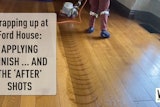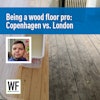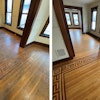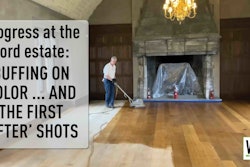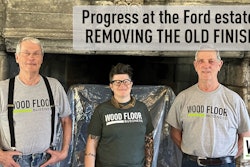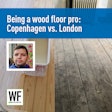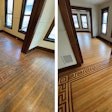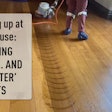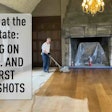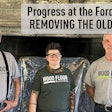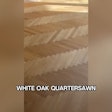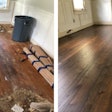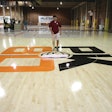The Problem
A distributor called about a finish situation one of his contractor customers was having. Then the home owner called wanting information on the finish situation. This was no small situation: It involved 7,000 square feet of Brazilian cherry. The situation: "poly bb's," "crack beading" or just plain polyurethane coming back up in the cracks. Everyone involved thought it was a finish failure.
The Procedure
The contractor installed the floor in the fall/winter as per NWFA and NOFMA suggested procedures, then sanded the floor and applied a first coat of oil-modified finish as a sealer. Then a second coat was applied, and everything looked good. The floor was covered up with red rosin paper two days after the second coat was applied. Several months later (early spring), when other work in the house was complete, the paper was removed and there appeared small "bb's" of polyurethane finish coming up in the gaps between the side joints. After scraping these away, the contractor applied a third coat of finish as the final coat and hoped that would solve the poly "bb" problems. Well, several days later it was happening again, but it was even worse.
After the contractor scraped the "bb's" away again, a week later he was called back by the home owner to remove more "bb's" that appeared. He was called back every week for months with the same exact problem.
It came down to a job-site inspection in the summer by the finish representative, the distributor salesperson, the contractor, the builder and the home owners. There was nothing wrong with the job site — even though it was on the coast, there was no moisture or excessive humidity in the home. The floor looked great except where the poly "bb's" were coming up between the cracks, which was all over the house, upstairs and downstairs. The floor had expanded somewhat since installation.
The atmosphere was understandably a little tense, with the home owner wanting the beautiful floor she paid for and the contractor wanting answers.
The Cause
After some investigation, it was found that the contractor had used one brand of finish as the first coat and then a different brand for the succeeding coats. It is recommended that you not mix "systems" or brands. Even if it works nine out of 10 times, that one time when it doesn't could cost you a great deal, if not put you out of business entirely. It also makes diagnosis of the problem's cause very difficult.
All finishes dry from the top down. When the finish seeps down in the cracks, it stays in a wet state because there is no air movement. Then three things happen:
- More coats are applied
- The floor is covered
- Time goes by.
When more coats are applied, they just compound the problem. Then, covering the floor may affect the dry time by locking the solvents down in the cracks. In time, the floor expands and contracts. Expansion pushes the boards together, and the still-wet finish down in the gaps is squeezed up, forming the "bb's."
How to Fix the Floor
Believe it or not, this is not a finish problem. How do you know. The finish looked great on the face of the boards for all coats; the only issue was in the cracks.
The solution to this problem is time. Let the floor expand and contract and just keep removing the poly "bb's" that have cured or hardened with a putty knife or scraper. Do not attempt to screen the beads off, which will cause circular scratches in the surface. If there are poly "bb's" that are still soft, remove them with a putty knife or scraper and wipe the spot with a rag dampened with mineral spirits.
In the Future
Apply the finish as per manufacturer's recommendations with the correct spread rate. Remember, more is not better! Watch for excessive cracks. These can be trowel filled as per manufacturer's recommendations.
Also, pay close attention to the factors that affect dry time. Floors should be installed and finished at normal living conditions — that means with the windows and doors in place, all wet trades done, and the HVAC system running. It is important to control the job-site environment. Avoid high humidity and temperatures that can slow down the drying time of the finish.
Once the floor is finished, allow the finish to cure appropriately before covering. Check with the finish manufacturer for appropriate cure times and for acceptable materials that won't damage the finish.










